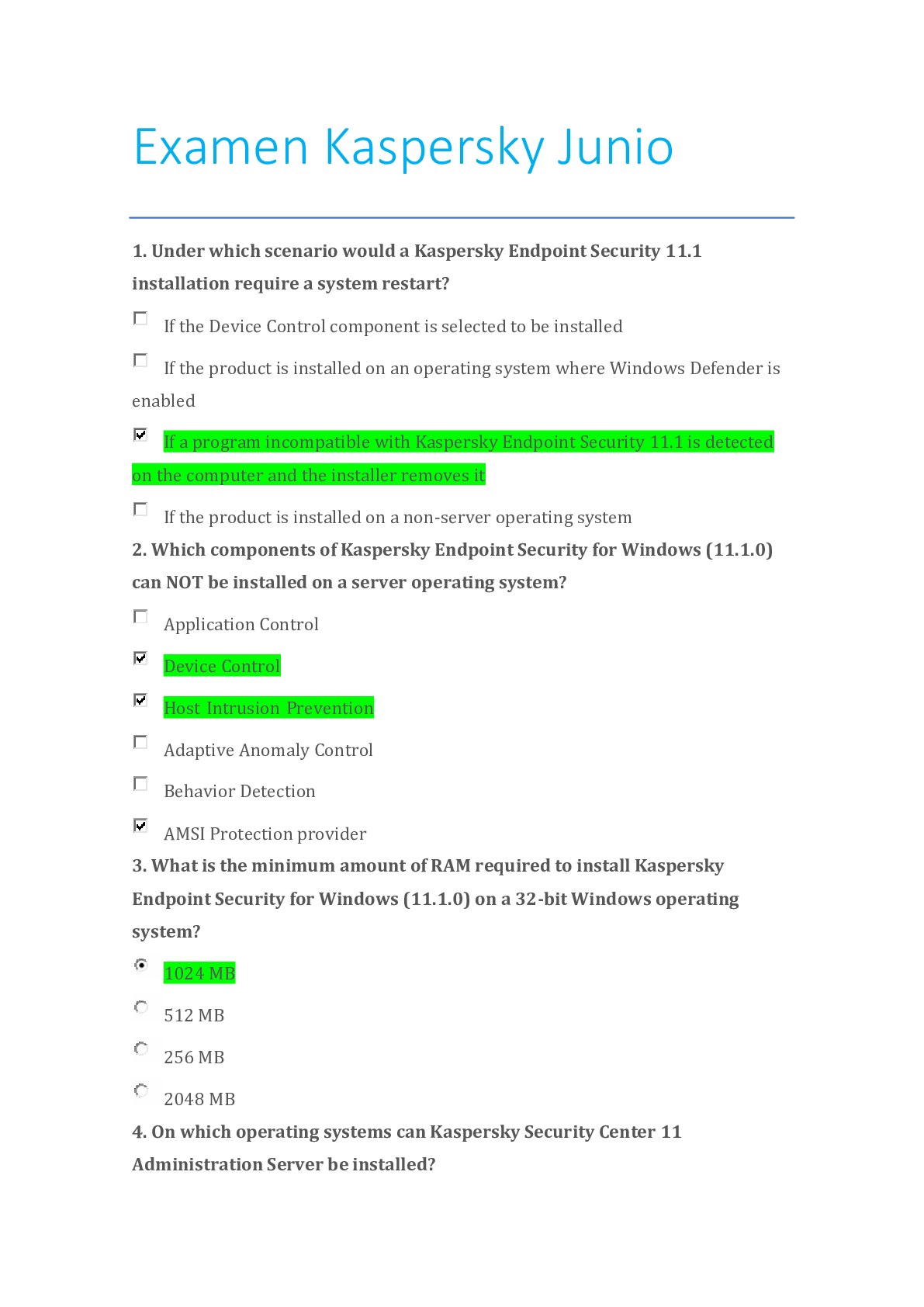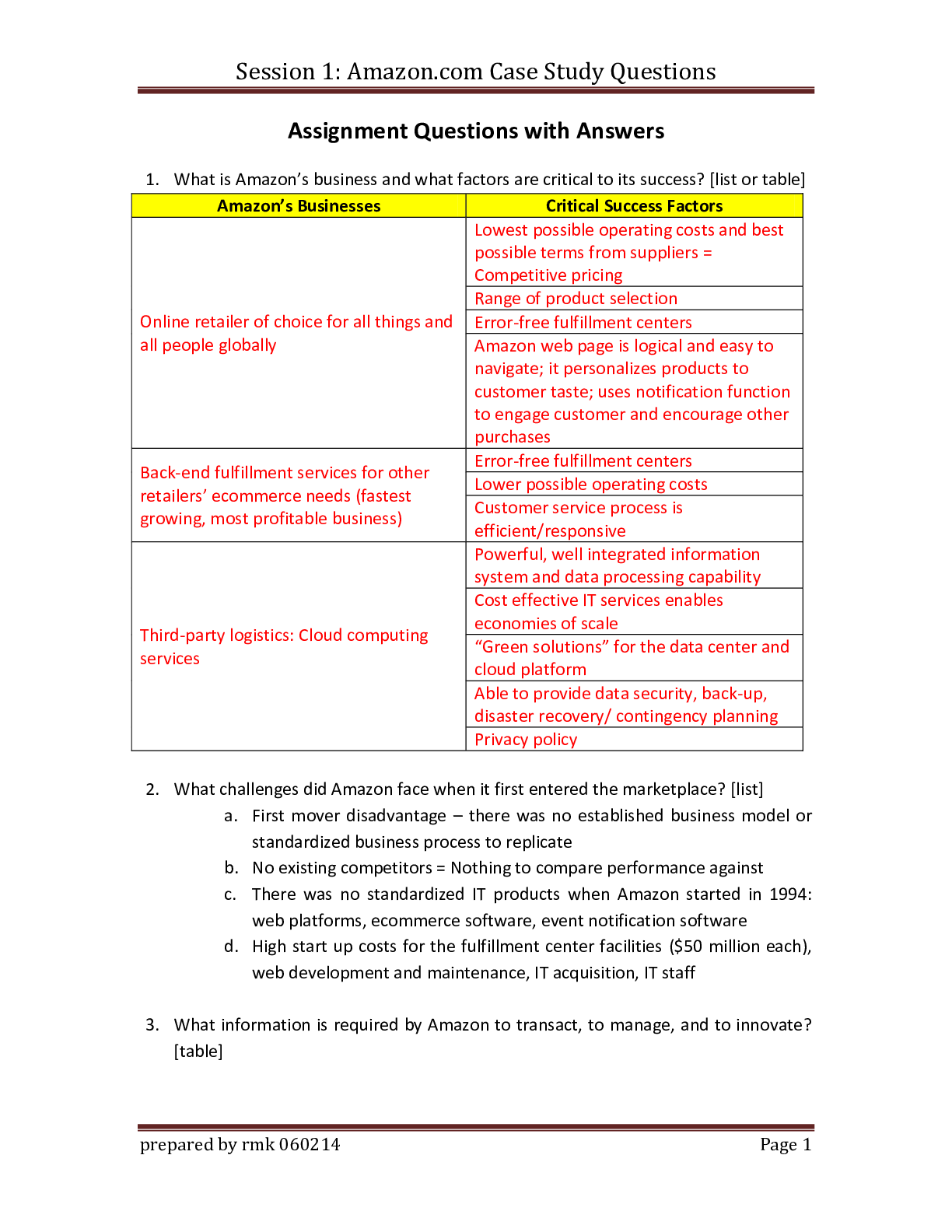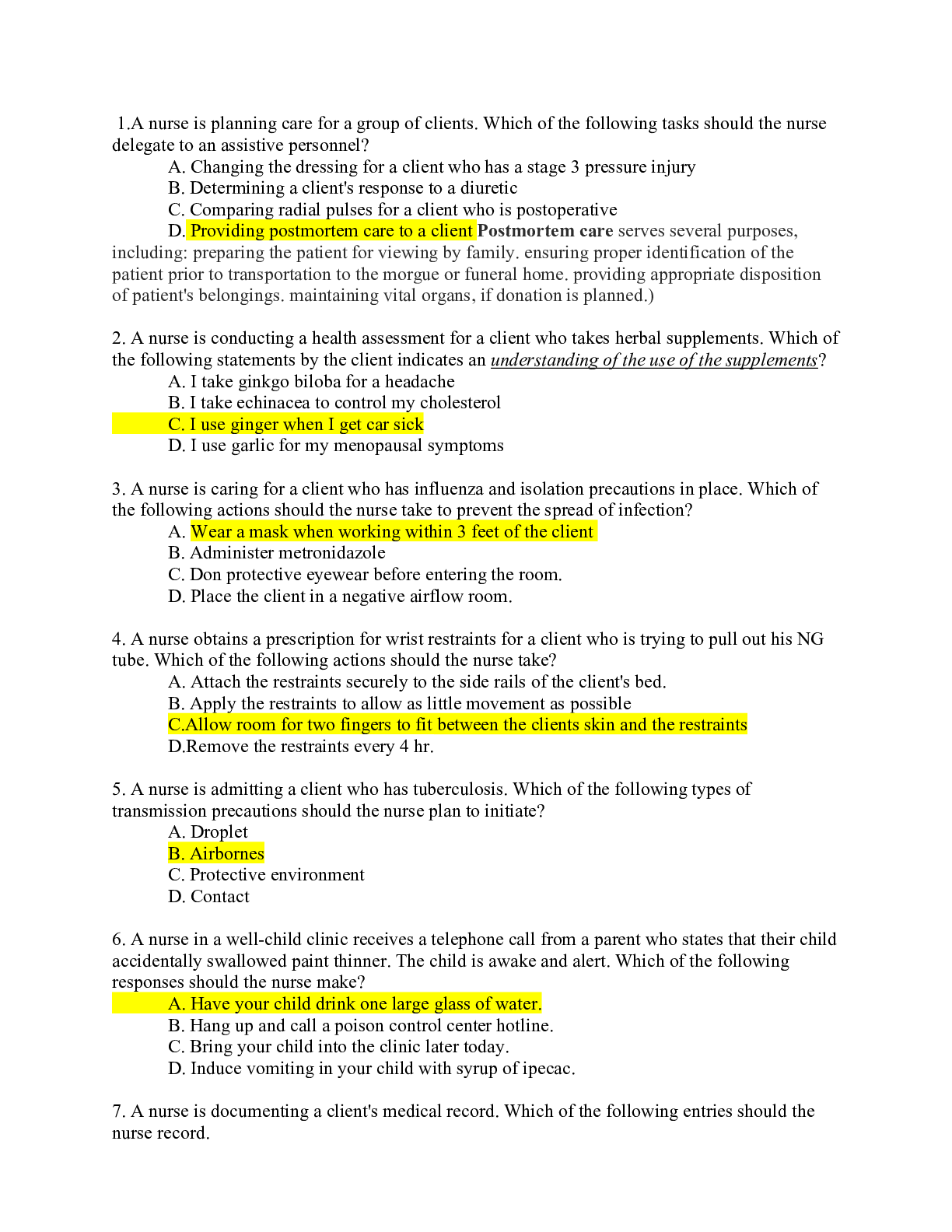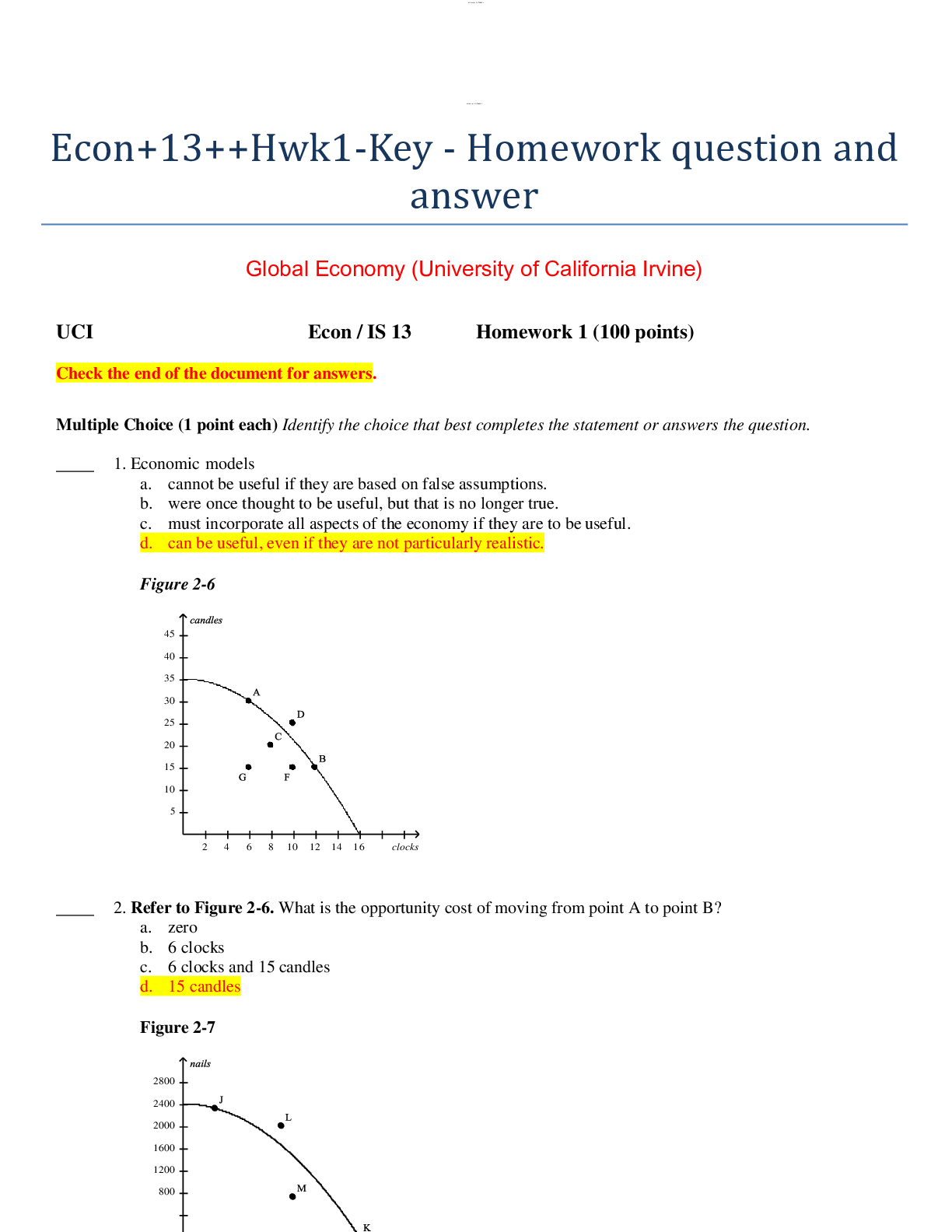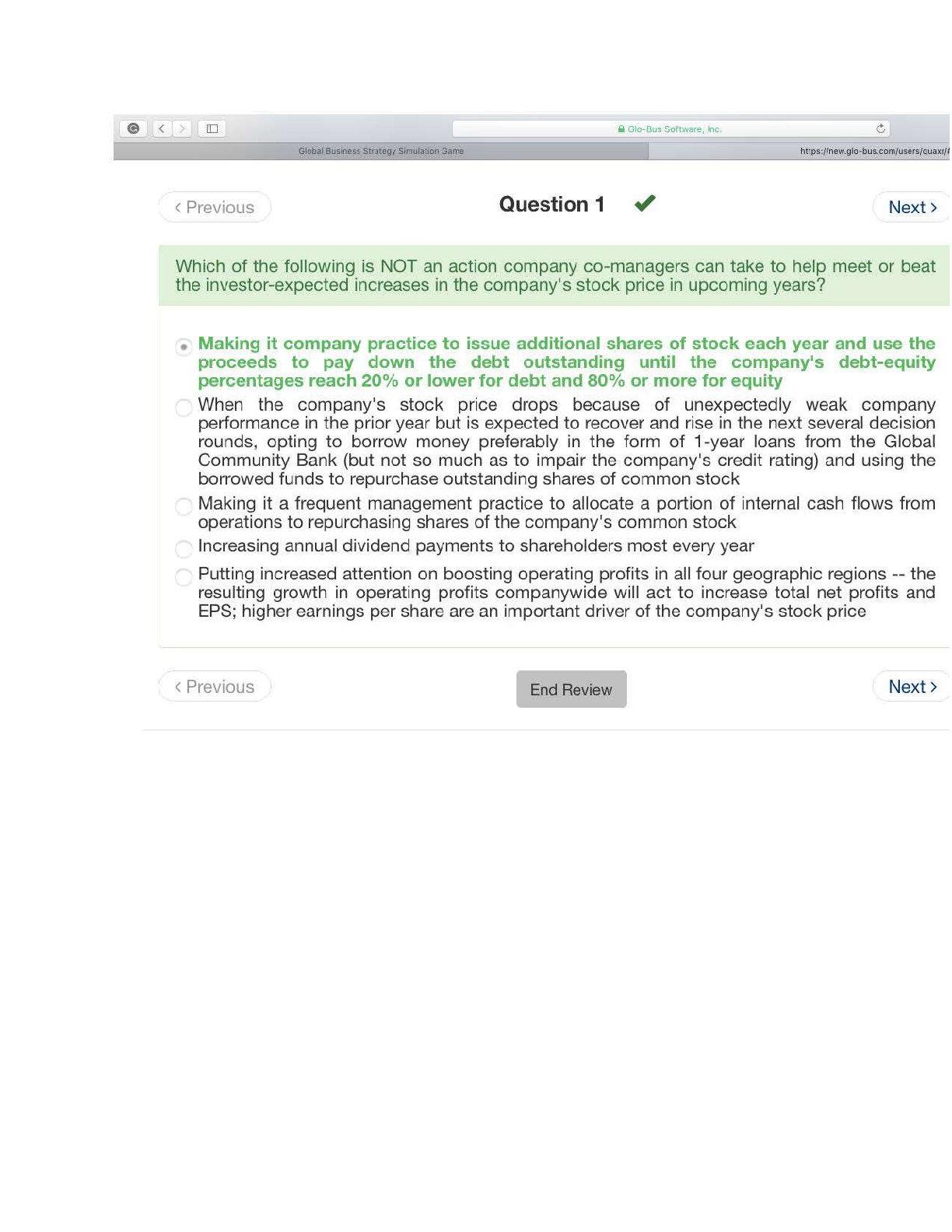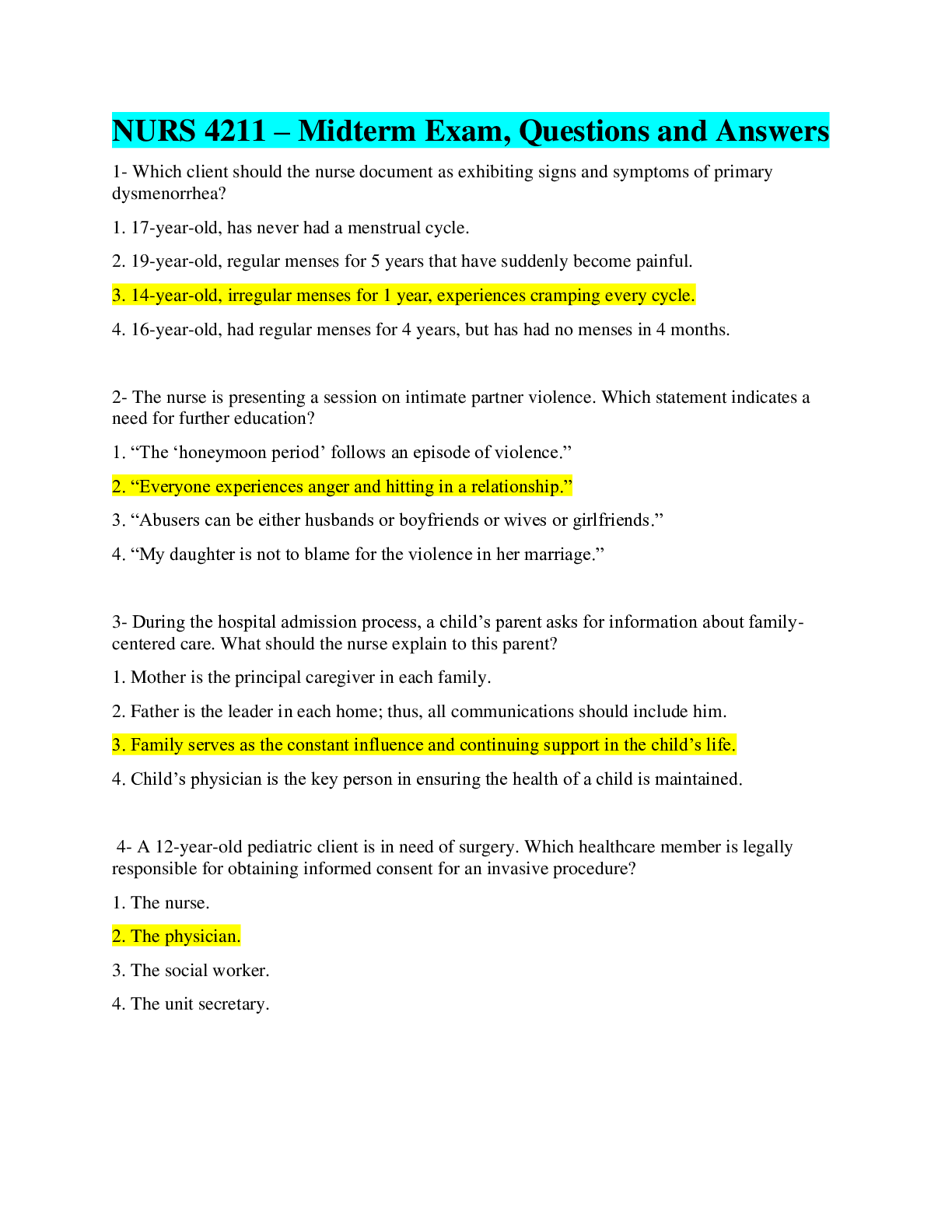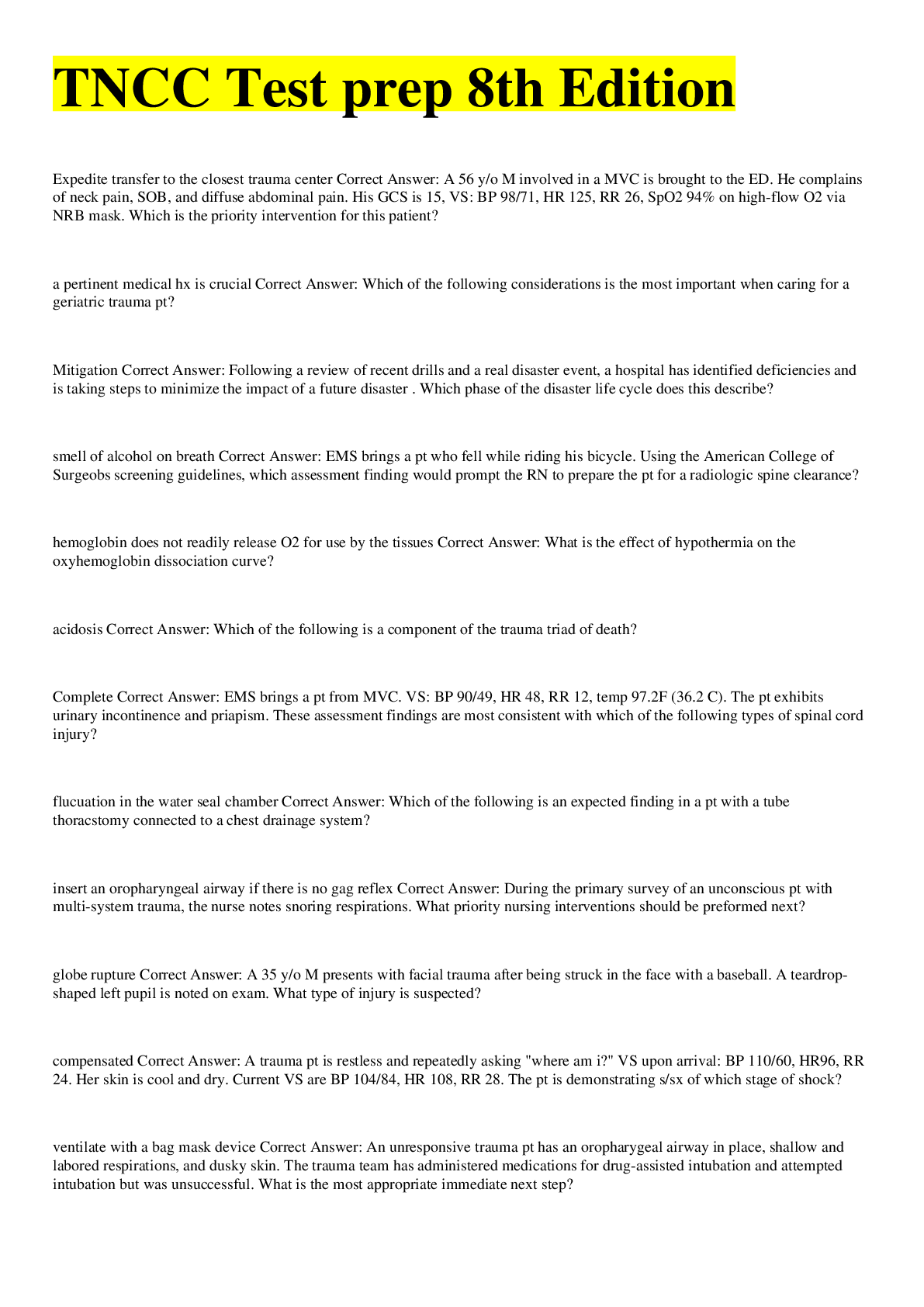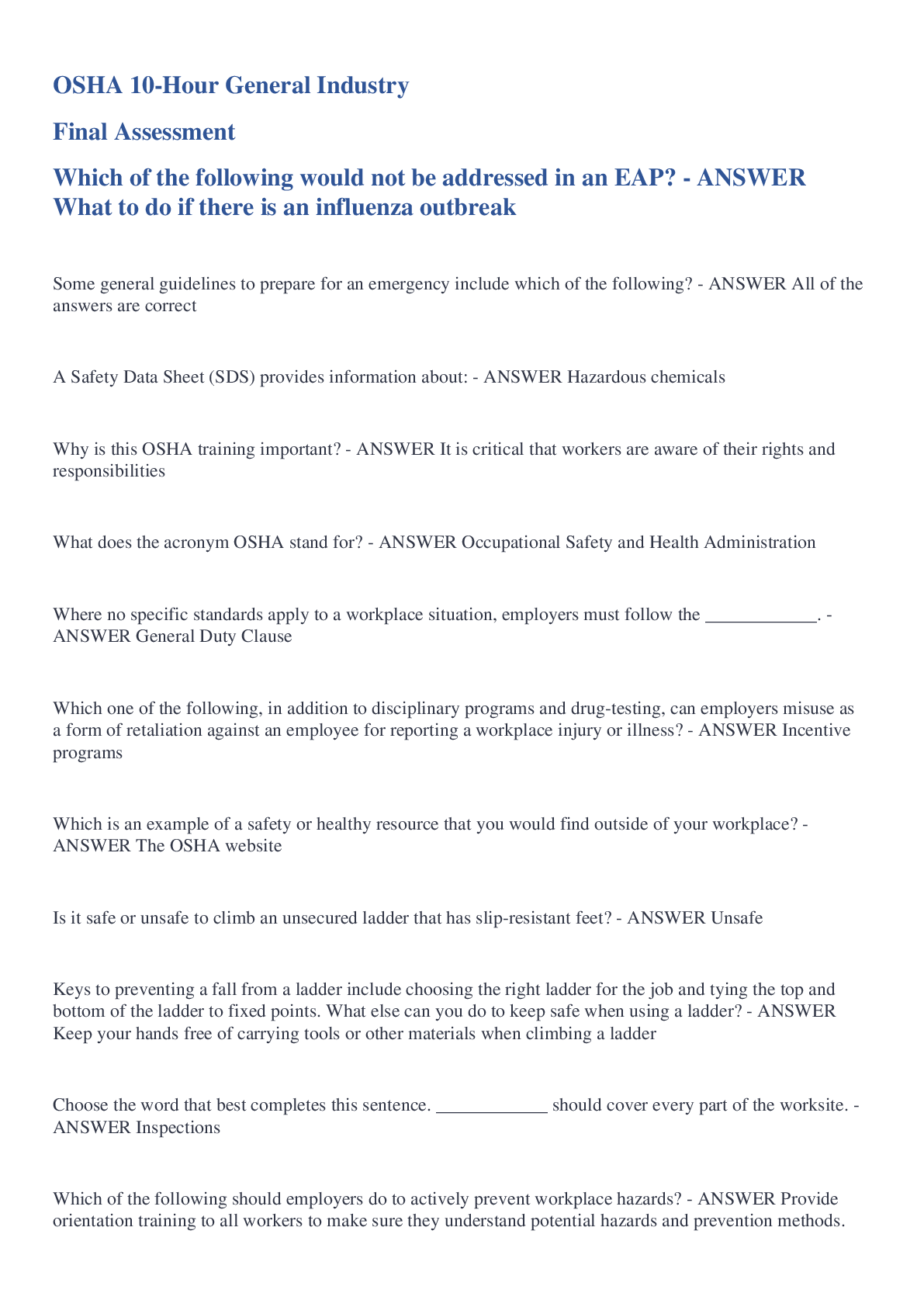*NURSING > QUESTIONS & ANSWERS > Clinical Nurse Leader (CNL) Certification Review Questions/ All Questions and answers. Rated A+ (All)
Clinical Nurse Leader (CNL) Certification Review Questions/ All Questions and answers. Rated A+
Document Content and Description Below
Patient satisfaction scores in emergency department have shown a downward trend over the past three quarters. As a clinical nurse leader in ED focus is to: A) Create a script for triage nurse in wel... coming the patient B) Assign a volunteer to welcome patients to the hospital C) Compare desired outcomes with national & state standards D) Write a letter of apology to each dissatisfied patient - ☑☑C) Compare desired outcomes with national & State standards Rationale: Client care outcomes are a measure of quality practice. CNLs must know how to compare desired outcomes that will improve safety, effectiveness, timeliness, efficiency, quality, and the degree to which they are client centered. Which of the following actions illustrates the CNL professional value of altruism? A) Leading an interdisciplinary team looking at the remote cardiac monitoring process B) Sponsoring a meeting with the monitor technicians to understand their barriers in the cardiac monitoring process C) Flow mapping the admission process of the remote cardiac-monitored patient D) Editing the policy for the remote cardiac monitoring process. - ☑☑B) Sponsoring a meeting with the monitor technicians to understand their barriers in the cardiac monitoring process Rationale: Altruism is a concern for the welfare & well-being of others. In professional practice, altruism is reflected by the CNL's concern for the welfare of clients, other nurses, and other health care providers. You are a CNL on the tele unit & orienting a newly graduated nurse. Critical thinking is best demonstrated when: A) The CNL discusses with the physician the rationale for discontinuing cardiac monitoring in the hospice patient B) Drawing the scheduled cardiac enzymes q8h Reviewing the patient care guidelines & protocols related to hourly rounding D) The CNL balances both the charge role & the preceptor role simultaneously - ☑☑A) The CNL discusses with the physician the rationale for discontinuing cardiac monitoring in the hospice patient Rationale: Critical thinking underlies independent & interdependent decision making. Critical thinking includes questioning, analysis, synthesis, interpretation, inference, inductive & deductive reasoning, intuition, application, & creativity. You are a CNL selected to lead a team focused on implementing a multidisciplinary clinical pathway for acute ischemic stroke & transient ischemic attack. The risk assessment tool that you have adopted identifies all of the following as independent stroke risk factors except: A) Age B) Systolic BP C) Liver dysfunction D) Current smoking E) Diabetes mellitus - ☑☑C) Liver Dysfunction Rationale: Independent stroke predictors include age, systolic BP, hypertension, diabetes mellitus, current smoking, established cardiovascular disease (any one of myocardiac infarction, angina, coronary insufficiency, congestive heart failure, or intermittent claudication), Afib, & left ventricular hypertrophy on ECG. A lack of compliance with DVT prophylaxis has been identified in retrospective chart reviews of all ischemic stroke patients in your organization. As a CNL on the neurological unit, your primary goal will include: A) Challenging the guidelines on primary prevention of ischemic stroke written by the American Stroke Association B) Gaining an understanding of how DVT prophylaxis is initiated on each stroke patient on your unit C) Developing an organization-wide educational program on DVT prophylaxis D) Developing a unit-based team of nursing personnel to investigate the problem. - ☑☑B) Gaining an understanding of how DVT prophylaxis is initiated on each stroke patient on your unit. Rationale: White Paper: One competency is that of a systems analyst. A CNL participates in a system review & conducts a microsystem analysis, identifying a clinical issue with a focus on a particular population. You are working on improving the patient discharge process. Which of these targets would best reflect clinical microsystem outcomes? A) Hospital length of stay B) Time of discharge order for all medical patients to the actual time the patient left C) Number of discharge orders on your unit entered before 11am D) Total number of discharged patients leaving by llam - ☑☑C) Number of discharge orders on your unit entered before 11am Rationale: A CNL as an outcomes manager uses data to change practice & to improve outcomes. Selecting the most appropriate goals & targets will provide meaningful information. Electronic nursing documentation has recently been instituted in organization. Select a response that best defines a clinical decision support: A) A reminder to save & sign your admission assessment B) A visual red-alert when a patient's potassium is 6..8 mEq/L C) A pop-up to initiate the discharge instruction sheet with every physician discharge order D) An electronic nursing care plan - ☑☑C) A pop-up to initiate the discharge instruction sheet with every physician discharge order. Rationale: CDS is a computer-based program designed to assist clinicians in making clinical decisions by filtering & integrating vast amounts of information & providing suggestions for clinical intervention. CNL focus on projects within a clinical microsystem. A clinical microsystem can be best described as: A) A department-wide program focused on improving continuity of care & patient satisfaction B) Trending the post-op care on all surgical units C) The clinical & business processes of a single unit within an organization D) All medical & surgical units guided by a chief nursing officer - ☑☑C) The clinical & business processes of a single unit within an organization Rationale: The microsystem is described by the AACN White Paper as the practice level of the CNL. All are part of the data necessary for a CNL to fully understand & assess his or her clinical unit except: A) The organization financial statement B) The target population & age distribution C) The percentage of FTEs D) Rate of nosocomial infections E) Fall rates - ☑☑A) The organization financial statement Rationale: A comprehensive assessment of the clinical unit is a foundation for the work of the CNL but does not include the financial statement of the organization. In comprehending the "big picture" of the organization, the CNL should have an understanding of the financial health of the institution. The results of a quarterly report identify an increase in patient falls on the tele unit. Your first action will be to: A) Implement hourly rounding B) Gain an understanding of patient care practices on the tele unit C) Assign patient personal alarms to all patients at risk D) Revise the current fall risk documentation form - ☑☑B) Gain an understanding of patient care practices on the tele unit Rationale: Assessment includes gathering information about the health status of the client & analyzing & synthesizing those making judgments about nursing interventions on the basis of findings, evaluation, & managing of individual care outcomes. You have been asked to lead the tele fall prevention committee. Which combination of team members would best suit the initial phase of this group? A) A behavioral health APRN B) A staff RN C) A physical therapist D) The nurse manager E) All of the Above F) Only A, B, & D are needed - ☑☑E) All of the above Rationale: Health promotion & disease prevention knowledge includes methods to keep an illness or injury from occurring, diagnosis, & treating a disease in its early course. CNLs need to work with an interdisciplinary team to make ethical decisions, develop, & monitor comprehensive, holistic plans of care. There is a strong correlation between patient falls & delirium. Exercise programs focused on strength, functional performance, & balance training are effective steps in reducing inpatient falls. As a CNL in the ICU, you have observed several prolonged & fragmented processes of starting an IV line in a critically ill patient. All of the following considerations are necessary in identifying a THEME for your improvement process except: A) A thorough review of the clinical unit B) The manager's mandate for change C) The alignment with the organization's strategic priorities D) Input from the patient's family - ☑☑B) The manager's mandate for change Rationale: Specific mandates for change would be considered as the team "drills down" for further information. The hospital is looking to utilize cardiac monitor watchers. Your analysis includes all of the following except: A) A review of an online ECG monitoring education program B) Identifying a clinical issue with a focus on a specific population C) Conducting a trend analysis of outcome data D) Analyzing barriers & facilitators with the organization - ☑☑A) A review of an online ECG monitoring education program Rationale: Systems analysis & risk anticipation are the competencies of the CNL. Several near misses were identified by ICU nurses who had mistaken invasive lines for IV ports for medication administration. You have completed an analysis for the issue. Your recommendations include: A) A visual signal on all ports not intended for IV drugs B) A double-check system for medication administration C) To facilitate a critical incident reporting structure that fosters a "without blame) unit culture D) All of the Above E) Only C - ☑☑D) All of the above Rationale: The CNL should support the staff to identify all opportunities for improving safety in this situation. Data reported by ICU quality committee reflect challenges in the management of the septic patient. As a CNL in the ICU, all of the following are first steps in evaluating the delivery of client care except: A) Knowledge of sepsis guidelines B) Critical care clinicians staffing ratios C) Use of clinical decision support systems D) Differentiating sepsis from systemic inflammatory response syndrome (SIRS) - ☑☑D) Differentiating sepsis from systemic inflammatory response syndrome (SIRS) Rationale: Nursing leadership & advocacy reviews & evaluates care guidelines & protocols A fellow staff nurse is struggling to understand the use of a clinical decision support system (CDSS) in the management of her septic patient. Your initial teaching strategy includes: A) Sharing the latest clinical research B) An understanding of expected & actual outcomes C) Defining the purpose of CDSS D) Exploring challenges, risks, & benefits - ☑☑C) Defining the purpose of CDSS Rationale: CDSS supports a safe patient culture & should be designed to help providers You are using failure mode & effect analysis (FMEA) to anticipate the risk of medication errors in the ICU related to invasive lines. You begin your FMEA analysis with: A) The effects of each failure B) The potential cause of each failure C) Process mapping D) Specific defects & delays in the medication administration process - ☑☑C) Process mapping Rationale: Utilizing tools for process improvement can provide new insights into routine practices. Your colleagues have identified challenges in the process of inserting an IV line. To gain a better understanding of what this process entails, you: A) Directly observe the IV line insertion process & time each step of the process B) Create a workflow diagram tracing the path of the nurse during the line insertion process C) Engage the IV team to reeducate the nurses D) All of the Above E) A & B - ☑☑E) A & B Rationale: Proper assessment of a clinical situation can expose issues of policy, compliance, or the need for education. The result of a workflow diagram of a clinician illustrates an excessive amount of walking to obtain supplies. Reducing the waste of motion adds value-added time that ultimately benefits: A) The patient B) The clinician C) Documentation D) None of the above - ☑☑A) The patient Rationale: Process improvement enhances patient safety & nursing time at bedside for the patient & family Your team is looking at the delays in the discharge process. Your cause & effect diagram includes: A) A run chart B) A Gannt chart C) A fishbone diagram D) A high-level flowchart - ☑☑C) A fishbone diagram Rationale: A fishbone diagram is a useful tool to identify themes of clinical issues. Categories such as equipment, personnel, communication, & so on can be identified. You are leading a palliative care team in the ICU. Ethical competence is best defined as: A) The ability to recognize potential & actual ethical issues arising from the clinical practice B) The collaboration with a multicultural workforce C) The understanding of the physical, emotional, & spiritual health parameters of the ICU patient D) The skill set to define, design, & implement culturally competent health care providers. - ☑☑A) The ability to recognize potential & actual ethical issues arising from clinical practice Rationale: The CNL's role in ethics is highlighted in AACN's White Paper Opportunities that reflect human diversity include: A) Promoting effective communication for injured veterans B) Stressing the importance of family health history C) Standardizing the discharge process D) Decreasing the admission lead time to the pediatric unit - ☑☑A) Promoting effective communication for injured veterans Rationale: Human diversity includes understanding the ways cultural, ethnic, socioeconomic, linguistic, religious, & lifestyle variations are expressed. Survey results of the nursing staff reflect poor perceptions & a discomfort with addressing spiritual issues with patients. The ultimate success of focused staff education can be measured by: A) Trending quarterly patient satisfaction scores pertaining to spiritual care during the hospitalization B) A follow-up survey of the staff after the education to solicit feedback C) An open discussion of how the nurse would address spiritual care in a given scenario D) Feedback shared during discharge phone calls - ☑☑A) Trending quarterly patient satisfaction scores pertaining to spiritual care during hospitalization Rationale: Application of knowledge that impacts patient outcomes is the most significant indicator. Sustaining process improvement requires the use of appropriate learning principles & strategies. The CNL function that best utilizes this competency is: A) Advocate B) Educator C) Clinician D) Information manager - ☑☑B) Educator Rational: CNL competencies are described in the AACN White Paper How can the CNL make the greatest impact on the health care organization? A) By representing the microsystem B) By representing the mesosystem C) By representing the patient and family D) By representing the nursing profession - ☑☑A) By representing the microsystem Rationale: The CNL functions as the change agent at the microsystem level, engaging frontline staff in best practices to better patient outcomes. By leading which unit initiative can the CNL directly impact the financial health of the entire institution? A) Reducing readmissions B) Recruitment of new nursing staff C) Improving documentation compliance D) Encouraging staff to report safety events and near misses - ☑☑A) Reducing readmissions Rationale: Medicare reimbursement rates include a penalty to those health care institutions with 30-day readmission rates that are higher than national benchmamrks. The concept that an organization is in a continued state of change describes which organizational theory: A) systems theory B) Classic theory C) Contingency theory D) Chaos theory - ☑☑D) Chaos theory Rationale: The chaos theory is based on the principle that a system can maintain itself only if change is occurring somewhere in the organization all the time. Chaos & change are seen as means of survival. The new hospital CNO works hard to cultivate a shared vision of leaders & followers motivating each other toward their highest potential. This is an example of which type of leadership? A) Transformational leadership B) Transactional leadership C) Situational leadership D) Hierarchical leadership - ☑☑A) Transformational leadership Rational: A transformational leader believes that leaders & followers motivate each other toward the end goal of developing followers into leaders. This is accomplished by leading & motivating by example. Before beginning data collection, what is the primary key factor to determine? A) Personnel to collect data B) A secure database for holding data C) Operational definitions of data D) A user-friendly collection method - ☑☑C) Operational definitions of data Rationale: Operational definitions clearly define what is to be collected & avoid confusion for those collecting the data. Clear operational definitions also helps those who are interpreting the data. Failure to determine operational definitions may result in data that are inaccurate. You are the CNL on a 25-bed cardiac unit. You are completing afternoon rounds with the patients. Upon entering Mr. K's room you notice that his son has brought him friend chicken, soda, & fries. How should you address this? A) Don't say anything to the patient or family & tell the interdisciplinary team at morning rounds B) Provide education to the patient & family abut consuming a heart healthy diet C) Place a consult in the computer for the nutritionist to assess the patient D) Remind the patient why he is in the hospital & remove the food - ☑☑B) Provide education to the patient & family about consuming a heart-healthy diet Rationale: You are in the room currently & can provide real-time education to the patient & family. It is an opportunity to educate the patient/family on how to make heart-healthy choices. As a follow-up you should place a consult for the nutritionist to follow-up. As the CNL on a Cardiothoracic step-down unit, what is the one recommendation you would make to decrease the chance of readmission of your patient population? A) Visiting nursing for all patients B) All follow-up appointments scheduled prior to patient discharge C) Pharmacy to visit with each patient prior to discharge home to review medications D) All patients should be enrolled in a cardiac rehab program - ☑☑D) All patients should be enrolled in a cardiac rehab program Rationale: All patients should be enrolled in a cardiac rehab program to assist the patient with making permanent lifestyle changes required to improve their health, well-being, & success after their illness. Because these programs provide ongoing support, teaching & monitoring of health, it is the best choice. You know teaching was effective to a cardiac patient & his wife with the following statement: A) "I can still have a burger & fries on to two times a week" B) "It is okay for my wife to bring in a pizza while I'm here; after all the hospital food is not that good" C) "I should limit my salt intake & increase fiber in my diet" D) "If my husband wants fried shrimp, it's okay because it's seafood" - ☑☑C) "I should limit my salt intake & increase fiber in my diet" Rationale: Cardiac patients should be on a sodium-restricted diet. Fried foods & high-fat foods should be very limited & /or excluded from the diet. You are the CNL on a geriatric unit. When walking down the hall, you notice a high-risk fall patient attempting to get out of bed alone. After assisting the patient & ensuring safety, what should you do? A) Report the incident to nursing management B) Identify the patient's nurse & nursing assistant & confront them with the incident C) Develop a new fall prevention policy & post it in the unit conference room for all staff to view D) Obtain the fall statistics & present them at the next unit staff meeting & develop a team to look at revising a fall prevention committee - ☑☑D) Obtain the fall statistics & present them at the next unit staff meeting & develop a team to look at revising a fall prevention committee Rationale: Using objective data to determine the trends on the unit will allow the CNL to determine a baseline fall rate for the unit. Starting a fall prevention committee will empower frontline staff to determine with evidence-based research which implementation will best meet the needs of the patient population & the staff. As the CNL on a med-surg unit, you have noticed a trend over the last 3 months with patients having high blood glucose before lunch & after dinner. What is the best way to address this problem? A) Investigate whether the blood glucose monitors on the unit are accurate B) Provide an educational in-service about diabetes to the staff C) Ensure all patients with diabetes receive a consultation with the nutritionist D) Determine what other changes in processes have occurred on the unit in the past 3 months that could influence this trend - ☑☑D) Determine what other changes in processes have occurred on the unit in the past 3 months that could influence this trend. Rationale: While checking the accuracy of blood glucose meters, providing education to staff & patients is important. Other processes on the unit that have changed need to be further evaluated to determine their influence on patient outcomes. After careful review of unit processes, you have determined that self meal order program was introduced 3 months ago. With this program, patients have the ability to order meals when they are ready to eat rather than eating at predetermined times set by the hospital. This change has altered the timing of medications previously given with meals. What does the CNL do to improve this process? A) Develop an interdisciplinary team, including unit staff, nutritionist, diabetic educator, and meal service team members to investigate the self meal order program B) Have the nurse or nursing assistant order meals with patients; this way the nurse knows what time the patient orders meals C) When explaining the self meal order program to patients, instruct patients to notify staff when they order meals D) Have the meal service notify the unit secretary when meal orders are placed by patients - ☑☑A) Develop an interdisciplinary team, including unit staff, nutritionist, diabetic educator, & meal service team members to investigate the self meal order program. Rationale: Having an interdisciplinary team look at the entire process of the self meal order program will provide the team with innovative solutions to the problem. After completing unit audits, you have noticed the nurses are not completing AIR cycles documentation with pain management (AIR: assessment, intervention, reassessment). What should be done to improve documentation?: A) Tell the unit management which staff are documenting inappropriately B) Reeducate staff on the hospital documentation policy C) Remind staff of pain documentation during staff meetings & charge report D) Provide staff with a self-audit sheet as a way to review their own documentation during their shifts. - ☑☑D) Provide staff with a self-audit sheet as a way to review their own documentation during their shifts. Rationale: Giving staff a checklist will assist them in staying organized during their busy day. This will provide them a way to double check all their documentation before ending a shift. It also empowers staff to take ownership of their work. You are listening to report with a novice nurse. As part of mentoring new staff & supporting clinical decision making, you ask the new nurse which patient she would like to assess first. Which patient should this nurse assess first? A) 46yo receiving IV antibiotics therapy B) 60yo s/p liver biopsy C) 56yo with pneumonia D) 72yo hip replacement impatiently waiting for discharge - ☑☑B) 60yo s/p liver biopsy Rationale: Post-op liver biopsy patients have an increased risk of bleeding & need close monitoring after the procedure. The question does not indicate how recently the biopsy was done & therefore this is the best choice based on the information provided. To help patients maintain healthy skin while in the hospital, all of the following should be considered except: A) Provide patient with Q2h positioning/turning if patient is unable to self-position B) Ensure adequate protein intake C) Use bed surfaces known to prevent skin complications D) Allow patient to refuse bathing for days if uninterested, as the pt has the right to refuse care - ☑☑D) Allow patients to refuse bathing for days if uninterested, as the patient has the right to refuse care Rationale: While the patient does have the right to refuse care, a patient who would disengage with personal grooming for multiple days should draw the attention of the staff & CNL. Further investigation into the refusal & disinterest in self-care needs would be required to determine the underlying causes resulting in the patient's behavior & lack of care for self needs. A nurse on the unit comes to you & says that every shift he works day or night he finds at least one of his patients without an identification band in place. He is very concerned about patient safety & feels a harmful mistake could occur in the near future if the practice on the unit is not improved. What do you do as the CNL? A) Perform daily audits on all patients & report results to management B) Have the unit secretary make new ID bands for all patients daily so the charge nurse can place new bands on the patients daily C) Research a new style of patient ID bands since the current product does not stay on the patient properly D) Provide support to the nurse on the unit who determines the problem & help him identify areas in the process to improve pt ID - ☑☑D) Provide support to the nurse on the unit who determines the problem & help him identify areas in the process to improve patient ID Rationale: Part of the CNL's role is to provide staff with education, support, & the tools needed to improve practice. This nurse is already concerned about improving a process. As a CNL it is important to foster leadership & ownership instead of providing solutions to problems Over the past few weeks, nurses on the 30-ed medical unit have been complaining the MD orders related to O2 don't match what the patient is receiving. Often the patient has more than one O2 order at the same time. This leads to confusion for nursing & respiratory care staff & could harm the patient. How can the CNL improve the practice? A) Using the informatics team as support, create a hard stop in the computer that does not allow the physician to activate a new O2 order without discontinuing the previous order B) Tell the nurses they need to remind the doctors to keep orders up to date & have the nurses review orders at rounds with the team C) Meet with the unit hospitalist to make a plan to address the problem D) Do nothing since CNLs can't write patient care orders - ☑☑A) Using the informatics team as support, create a hard stop in the computer that does not allow the physician to activate a new O2 order without discontinuing the previous order Rationale: Having the informatics team develop a hard stop in the computer will allow the patient to have only one active O2 order at a time. It is imperative that nurses & CNLs work with informatics professionals in the design of safe care. The hospital has a goal for patient transfers from ICU to be completed by 12 noon. Your unit has a very low percentage for meeting this hospital goal. How can you best address this problem as the CNL? A) Tell the charge RN to discharge patients in the morning B) Ask the manager to staff an extra nurse on day shift to be the discharge nurse C) Use process mapping to determine all the possible factors that contribute to patient discharge & what barriers there are to discharge D) Don't worry about the number; your unit meets the other hospital goals, so it's okay to miss one - ☑☑C) Use process mapping to determine all the possible factors that contribute to pt discharge & what barriers there are to discharge Rationale: Process mapping is a tool to provide the team with an objective view of the problem being investigated. This view will help everyone to determine the barriers to transfer. Once the barriers are determined through process mapping, each barrier can be broken down further to determine solutions. You are the CNL at an outpatient care clinic providing care to families in the area. You have noticed it is difficult to get families to bring their children in for their immunizations, & children are often off schedule. How can the clinic best address this issue to meet the needs of their patient populations? A) Educate families on immunizations, their purpose, & their children's schedule B) Provide reminder phone calls to families the day before a scheduled appointment C) If possible, offer extended clinic hours 1 to 2 nights a week, so parents can come in after work D) Use the clinic data to determine why families are not coming to appointments - ☑☑D) Use the clinic data to determine why families are not coming to appointments Rationale: Before making changes at the clinic, it would be best to look at the data objectively to determine what is causing the problem. Answers A, B, & C assume you know the families' reasons for not coming to appointments. You are the CNL in the day surgery center & have found that many patients come to the center unprepared on the morning of surgery. This delays surgery start times & backs up the OR schedule for the day. The whole surgery team is frustrated. How can the process be fixed? A) Change the first surgery start time & delay it by 20min B) Institute presuregery phone calls 2 to 3 days prior to a patient's scheduled appointment C) Stagger surgery start times more throughout the day D) Reschedule patient show come to the center unprepared - ☑☑B) Institute presuregery phone calls 2 to 3 days prior to a patient's scheduled appointment Rationale: Having a nurse call the patient before the morning of surgery will allow the patient to ask questions & review what to do the night before & the morning of surgery, to help ensure patients arrive to the center ready & prepared for surgery. This may also help reduce patient anxiety prior to a procedure, thus arriving better prepared. Per the epidemiology report, your unit's hand hygiene scores have steadily decreased over the past 3 months. When reporting these metrics at a staff meeting, most of the staff replies saying, "It's the doctors fault, we always wash our hands." How do you work to change the culture of the unit? A) Have secret shoppers monitor the staff & hand out tickets to hand hygiene offenders B) Collect hand hygiene metrics related to the unit staff only & use these data to educate staff C) Have a hand hygiene campaign to reinvigorate staff D) Investigate the barriers to hand hygiene & collaborate with staff to reduce these barriers - ☑☑D) Investigate the barriers to hand hygiene & collaborate with staff to reduce these barriers Rationale: Giving staff warnings, presenting objective data & highlighting a problem may improve compliance only slightly. Finding out the root cause for noncompliance & collaborating with staff to find viable solutions will change for unit culture over time & empower staff to make positive changes to their work environment. A new nurse on the med-surg unit approaches you with concerns about one of her patients. She states the patient has not turned on the lights or TV all day & did not order breakfast or lunch. She had to sk the patient what meal they wanted & place the order. This nurse states she is concerned about the change in the patient's behavior. Looking at the patient's chart, you realize this patient is Jewish & it is Saturday. What is the best response to the nurse? A) "The pt is sick & needs extra support today" B) "The pt needs to be seen by the psychology team for an evaluation" C) The pt may be following their religious practices & we need to support this D) Begin being in the hospital - ☑☑C) "The patient may be following their religious practices & we need to support this" Rationale: We need to support patients' religious practices whenever possible in the hospital. onsidering it is Saturday & this patient is Jewish means the patient is recognizing the Sabbath. This means the patient will not use any electrical devices or ask to use them. The staff would have to ask whether a patient wants the TV on or the lights turned on/off, & so on. Patients will also not use the phone or call bell system during the Sabbath. Staff need to be sensitive to patient needs & try to accommodate cultural & spiritual practices whenever possible. When trying to implement a change in the outpatient family clinic, which group of staff should the CNL focus on more? A) Late majority B) Early majority C) Laggards D) Innovators - ☑☑A) Late majority Rationale: The innovators & early majority are going to be supportive of change & become champions for the project. The laggards make up a minority portion of the group & will be the last to adopt change. However, the late majority, which makes up a large percentage of the group, is the percentage that will need the most support during a change & they will be resistant As the CNL on medical unit, which of the following interventions would you support to reduce the readmission rate on your unit? A) Keep patients one extra day to ensure they are prepared for discharge home B) Arrange for all patients to have at least 1 week of visiting nursing post-discharge C) Review discharge instructions with the patient and one family member D) Begin discharge planning & teaching on the day of admission - ☑☑D) Begin discharge planning & teaching on the day of admission Rationale: Using every opportunity to communicate to & educate the patient & family on their care & planning for discharge will better prepare the patient & family for returning home. You are the CNL on a 32-bed med-surg unit. When you walk into the unit, you observe a novice nurse looking extremely busy & stressed. How can you best support her transition on the unit? A) Ask the charge nurse to decrease her patient assignment B) Give some of her morning medications C) Pull the nurse off the unit during her shift D) Meet with this nurse after the shift to discuss organization - ☑☑D) Meet with this nurse after the shift to discuss organization Rationale: As the CNL you should meet with the novice nurse when she is not scheduled to offer support, guidance, & assistance while she transitions from novice to expert. Newer nurses need help with organization & managing tasks to help support their critical thinking skills. Which type of evidence would you prefer to review & share with a team when trying to support whether an Evidence-based intervention should be implemented on your unit? A) Meta-analysis B) Quasi-experimental C) Experimental D) Qualitative - ☑☑C) Experimental Rationale: Experimental research is quantitative research, which is a formal, objective, rigorous, & systematic process for generating information about the world. Experimental research is an objective, highly controlled investigation for the purpose of predicting & controlling phenomena in nursing practice. Which group presents the highest challenge in attaining buy-in for a new innovation? A) Early innovators B) Early adopters C) Late majority D) Laggards - ☑☑C) Late majority Rationale: Members of the late majority approach any new initiative with a high degree of skepticism & require a large amount of information before adopting change. They will adopt change only in the late stages. laggards historically will not adopt change. There has been disagreement regarding the suggested adoption of a patient transfer blackout period during change of shift. Staff on the inpatient units favor a 30min period, while ED staff favor no blackout period. A team of stakeholders from all areas recently agreed on a universal blackout period of 15min during shift change. What time of solution does this represent? A) Compromise B) Collaboration C) Accommodation D) Confrontation - ☑☑B) Collaboration Rationale: Collaboration involves all parties working together to design optimal outcomes using mutually agreed upon solutions. The CNL can effectively design fiscally efficient patient care using which of the following strategies: A) Division of tasks & responsibilities among all team members B) Delegation of responsibilities according to job roles C) Seeking team members' input regarding their strengths & desired responsibilities D) Using input from the manager for job assignments - ☑☑B) Delegation of responsibilities according to job roles Rationale: The CNL must delegate responsibilities to the appropriate team member according to job description. Each team member should function at the highest level [Show More]
Last updated: 1 year ago
Preview 1 out of 52 pages
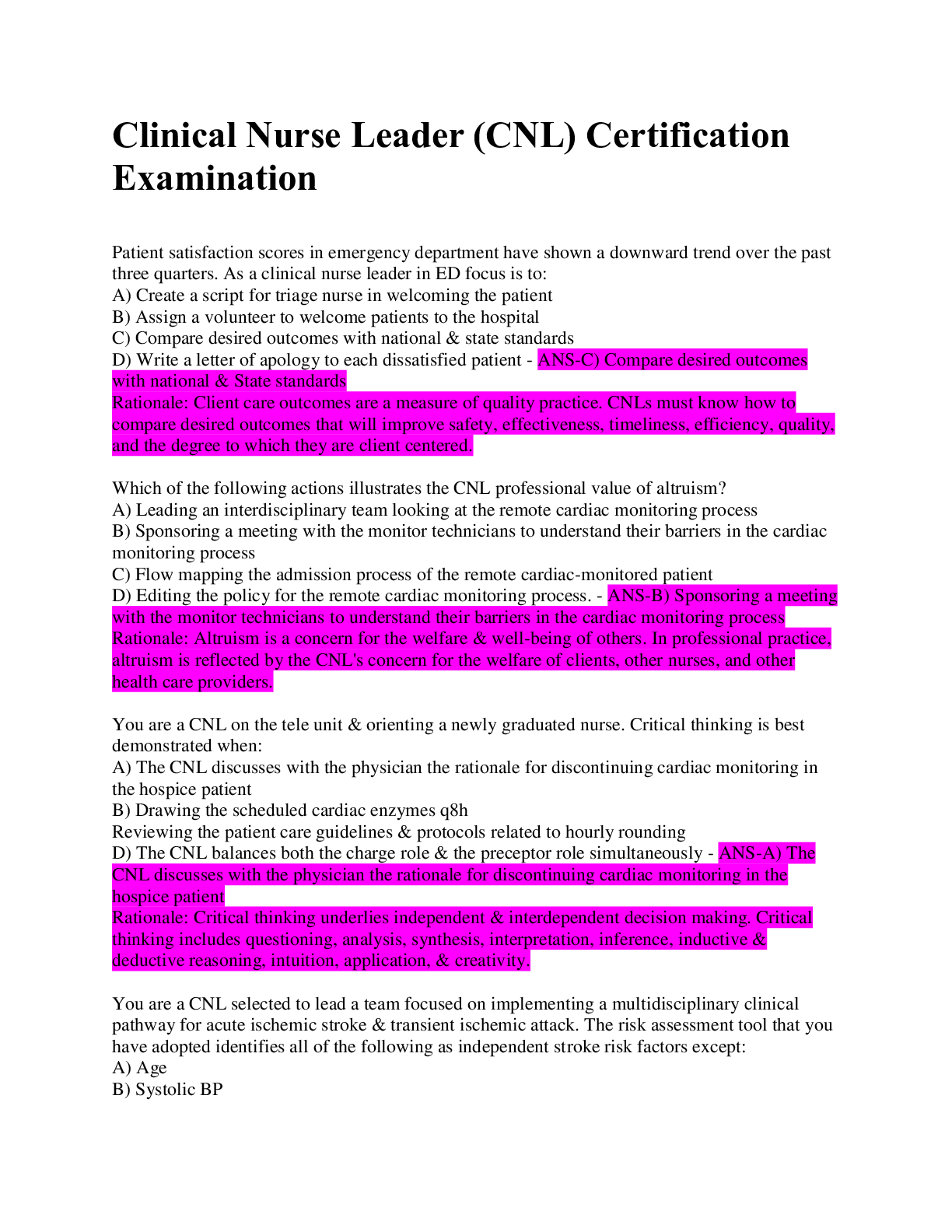
Also available in bundle (1)
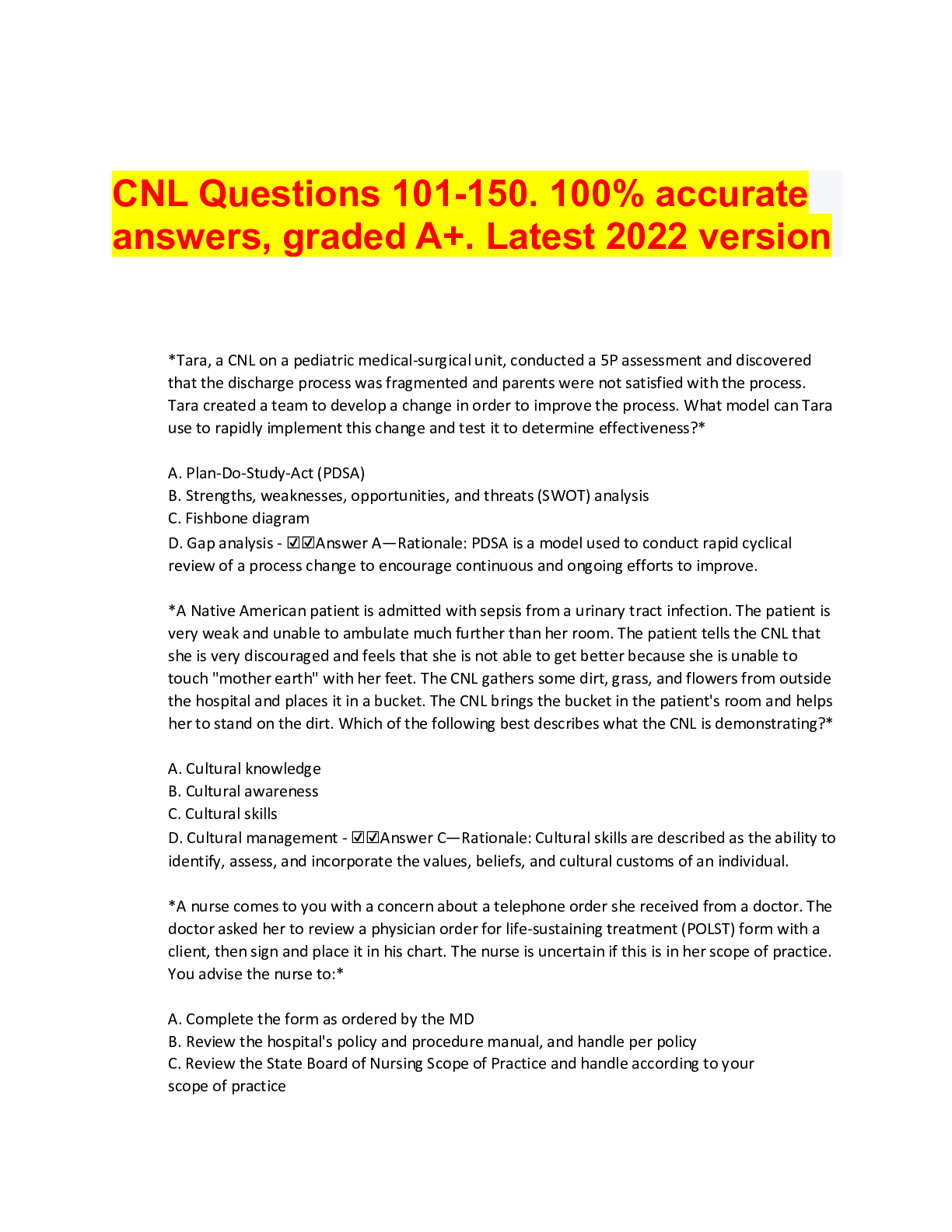
ALL CNL EXAM DOCUMENTS; QUESTIONS AND ANSWERS. PREDICTOR QUESTIONS. DOWNLOAD TO SCORE A+
Composed of 8 documents. All CNL questions and answers, latest versions 2022. rated A+
By bundleHub Solution guider 1 year ago
$28
8
Reviews( 0 )
Document information
Connected school, study & course
About the document
Uploaded On
Aug 07, 2022
Number of pages
52
Written in
Additional information
This document has been written for:
Uploaded
Aug 07, 2022
Downloads
0
Views
91














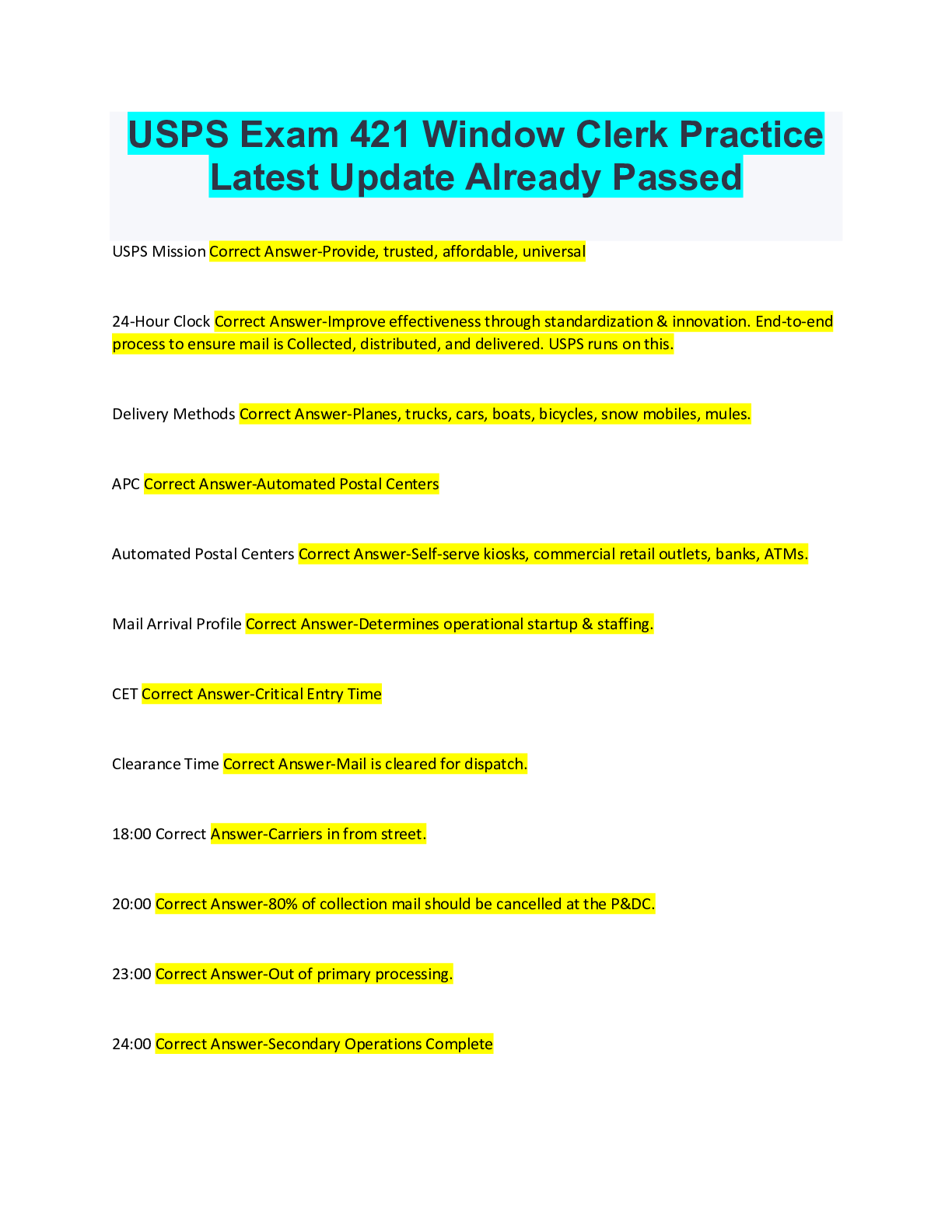



.png)

.png)



